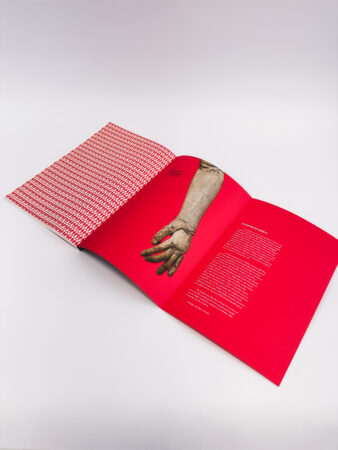
Features
Business
Building the next 90 years of Mitchell Press
Mitchell Press’s unique micro data approach is redefining how businesses bridge physical and digital realms
April 1, 2024 By Nithya Caleb
 Mitchell Press has evolved from a web offset/ digital printer to a comprehensive visual-
communications solutions provider. Photos © Mitchell Press
Mitchell Press has evolved from a web offset/ digital printer to a comprehensive visual-
communications solutions provider. Photos © Mitchell Press In 2023, one of Canada’s leading print companies, Mitchell Press, had a rebrand; it dropped the word ‘Press’ from all client-facing logos. As explained at that time by the company’s executive vice-president Scott Gray, “While our legal name remains Mitchell Press, we removed the word ‘Press’ from our client-facing mark because today our services are so much broader than print alone. While print remains an integral part of our business, we prefer a non-traditional approach by empowering print through data analysis, web development, graphic design, print management tools, and sustainable production solutions.”
The Mitchell Group consists of Mitchell, its digital marketing division, Project28, which focuses on web development, CGI renderings, and augmented reality, and Pacific Bindery and trade services. It was founded in 1928 by Howard T. Mitchell as a financial newspaper. The company, which is now in its third generation of family ownership, has evolved with the times from being a financial newspaper and web offset printer to digital printing and now, a comprehensive visual-communications solutions provider.
As the print industry goes through a tectonic change brought about by the Internet of Things, many companies have been diversifying, actively future-proofing themselves. In the last few years, Mitchell has also engaged in this exercise. The question uppermost in the minds of senior leadership has been, “How do we prepare the business for another 90 years of success?”

The Vancouver Art Gallery’s Incomplete History of the VAG 1931-2023 is a perfect bound book containing imagery ranging from archival BW to professionally shot artwork.
New perspectives
As part of this resilience strategy, the company hasn’t hesitated to seek advice and talent from outside traditional print corridors to help create a new vision for Mitchell. One such hire or find was A.J. Rai, VP-sales, Mitchell, who won the 2023 Emerging Leader of the Year Award at the Canadian Printing Awards late last year. Not to downplay the role played by others at Mitchell, Rai has been pivotal in the company’s active adoption of digital solutions. I spoke to Rai about how Mitchell is successfully merging the physical and digital worlds and the perspective shift required among printers for the industry’s long-term success.
In June 2017, Rai, who has zero print experience, joined Mitchell as the company’s first digital media specialist. Born and raised in Richmond, B.C., Rai’s background was in tech strategy. A mutual friend introduced Rai to Mitchell’s executive team. During the initial meeting itself, Rai began to see gaps around how the print industry views digital vis-à-vis the rest of the world. In the print industry, digital often refers to digital printing whereas ‘digital’ is far deeper and complex than that; it can refer to innumerable tools and software that can support a business process, Rai explained.
“Print is the only industry where we use digital to mean print and not digital like it’s perceived by the rest of the world. When we talk digital, it always means digital printing, short-run, machine, equipment. This is great but when we look at it from the perspective of the rest of the world, it’s confusing,” he said. For instance, a prospective client may seek your help with digital advertising after seeing ‘digital’ as one of your services. However, you’re only offering digital printing. These genuine gaps in communication make us wonder what the industry is missing by not combining the physical and digital worlds.
Rai came on board with the confidence that while print may have lost its power, it’s possible to use modern technology (read digital) to grow the overall business where print plays a significant role.
Rai’s first responsibility was to launch Mitchell’s digital solutions division. A consultative approach and in-depth knowledge of IT helped Rai understand Mitchell’s clients (old and potential), delve into the data in their CRM systems and how that could be used to address pain points in their businesses.
To understand this better, let’s look at real estate mailouts. Typically, developers send mass mailouts about a new property to residents in a specific postal code. Rai is suggesting a more targeted approach. Since developers have been in the business for decades, they must have data indicating which consumer is looking for what type of property. So, if a developer is looking to sell a 2BHK condo, they can, if needed, send personalized mailouts to consumers who are looking for a similar property. Such personalized, targeted mailouts would naturally generate a higher ROI than mass mailouts.
Another issue that Rai realized Mitchell could help their clients with was website development. Many clients either didn’t have a website or the site wasn’t user-friendly. By optimizing the website, Mitchell helped improve brand engagement.
“Your website is your first tool for sales and marketing. Through our own unique IPs, we’re able to watch people’s ‘behaviour’ on a website. We can map out how they’re interacting with the website. We can take this a little bit further as well by running it through our AI IPs where we record the data, look at the interactions and how it impacts creative. This data will allow us to decide the best places to include a call-to-action button to improve engagement and what colours/fonts/styles to use, as well as product positioning. We identify the metrics that need to be captured for our customers. This allows us to have a better understanding of the client’s goals and objectives and can help determine which Mitchell product can be offered to help the client,” he explained.
Micro data
The obvious corollary to the above discussion was the type of data that was being captured. Mitchell’s in-house term for that is micro data.
“It’s concise, intuitive, day-to-day data, actionable and readily accessible to anyone. Through Mitchell’s Project 28 discovery process it can be used immediately in an impactful manner, allowing you to maximize ROI,” Rai explained. “The data we’re collecting allows us to merge the physical and digital worlds and target consumers in specific ways.” Remember the real estate mailout example that was mentioned earlier?
In a nutshell, micro data refers to consumer behavioural data like demographics, time spent on website and pages viewed, purchase history, etc. Mitchell’s Project28, a joint venture with Toronto-based software firm Hypekraft Digital, focuses on capturing and interpreting that data at a granular level.

The Hip Trip Kit showcases the strengths of nanographic printing. It comprises a custom folding carton container, journal/sketch book, mini art prints, and custom baggage tags.
Enter the Nanographic press
Mitchell’s 360-degree approach didn’t pigeonhole them into one silo of the marketing conversation. Thus, they were able to convince customers to use Mitchell’s core business of ‘printing’ to achieve things like unboxing a brand-new shoe, customized packages, etc.
The Landa Nanographic Press is also playing a key role in Mitchell’s digital transformation plan.
In 2022, Mitchell became the first Canadian printer to invest in the Landa S10P Nanographic Printing Press. At that time, Gray said, “The Landa digital press pushes us to re-imagine print. Rather than producing 500 of one book, let’s create 500 books of one – completely personalized, with an incredibly high bar for quality. While mass customization was once a dream, today it’s a cost-effective reality.”
The Landa is allowing Mitchell to elevate its variable data printing capabilities. It has proven invaluable in Mitchell’s ability to blend digital technology and print.
“Landa allows us to take the metrics we’re getting from the web development, CRM, and ERP and transition them towards these [print] initiatives. We’ve done short runs for events and packaging for tea manufacturers. While sheetfed is great, Landa has simply automated the process,” explained Rai.

This gatefold cover book design called for accurate Pantone matching with solid colours, various screened elements and grey tints. It was printed on Mitchell’s Landa press.
Impact
Thanks to Mitchell’s company-wide focus on digital solutions and Rai’s vision to let data inform Mitchell’s client’s marketing decisions, the company’s overall sales volumes increased to pre-pandemic levels by early 2022, a fact that Gray highlighted in his application to nominate Rai to the Canadian Printing Awards program.
The team is now “adept at bridging the gap between print manufacturing and the digital realm. Leveraging data metrics and cutting-edge technology is helping the company transform the industry,” he added.
This article originally appeared in the January/February 2024 issue of PrintAction.
Print this page

